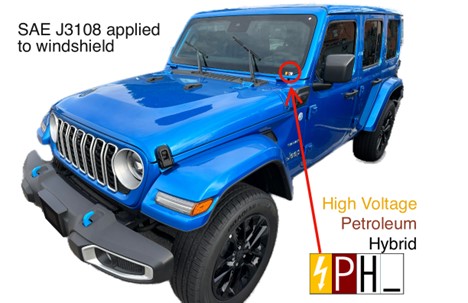SAE Responder Safety Group Introduces SAE J3108/1 Recommended Practice (RP) as an Identification Method for Alternative Fuel Vehicles
Guest Post by Robert Swaim, www.HowItBroke.com
SAE Hybrid and EV First and Second Responder Task Force J2990
Firefighters responding to car fires increasingly face an identification problem that can pose extreme risks. As high voltage lithium-based batteries become more common there are fewer ways to spot which cars have an internal combustion engine (ICE), is hybrid plug-in electric vehicle (PHEV), or an electric vehicle (EV). For example, the Hyundai Kona is offered in all three versions and while Jeep Wranglers seemingly all look alike, the model is offered in both ICE and PHEV versions. The subtle differences are a bulge in front of the driver mirror, blue tow hooks, and small blue text stating Wrangler and 4xe, all of which become even more inconspicuous on a dark or blue vehicle.

Due to a small number of defective lot of battery cells, Wrangler hybrids were involved in explosions and fires before a 2023 recall was issued. (NHTSA 23V-787)
Twelve US States and many foreign countries have developed a variety of license plate schemes to identify alternate fuel vehicles. Unfortunately, these have been too generic to be of much benefit, as most simply say “Electric Vehicle” or similar.

Wisconsin now requires license plates to have a red sticker showing the letters EV, regardless of whether the vehicle is powered by a lithium-ion battery or hydrogen fuel cell. The use of water may be the best way to fight fires involving lithium-ion batteries, while being undesired in a fuel cell vehicle because it can prevent the protective overpressure relief valve from functioning. Further, vehicles powered by various types of compressed or liquified gas have no special marking requirements, presenting firefighters with another extreme danger.
In response to this increasing identification problem, the SAE Responder Safety Group J2990 developed a Standard Four-Letter Coding as an Identification Method for Alternative Fuel Vehicles. The J3801/1 Recommended Practice (RP) was released on March 1, 2024 and New York is the first State introducing legislation to require it.
T he RP provides an intuitive way to define how a vehicle is powered by using an existing international set of colors and letters. For example, a battery electric vehicle would have a small sticker with the international high voltage symbol of a spark on an orange background.
he RP provides an intuitive way to define how a vehicle is powered by using an existing international set of colors and letters. For example, a battery electric vehicle would have a small sticker with the international high voltage symbol of a spark on an orange background.
The sticker for a hybrid has the orange spark followed by a red P for Petroleum and H for Hybrid.

Hy drogen vehicle stickers are based in blue colors and may have a
drogen vehicle stickers are based in blue colors and may have a W to alert firefighters that the emergency response guide (ERG) must be consulted because some aspect of using water may be detrimental.
The colors and letters have been largely adopted from International Standards Organization (ISO) 17840, which portrays various fuels in a diamond shaped symbol. The diamond format is intended for trucks, busses, fire equipment and other large vehicles, but loses legibility at the small size needed for the corners of a license plate, similar to what Wisconsin now does.
The new RP was developed because the National Highway Traffic Safety Administration (NHTSA) does not require manufacturers to mark alternate fuel vehicles, and manufacturers will not do so on their own. While the J3801-1 document was written with the intent of the stickers being placed on license plates, New York has taken a different approach by requiring the stickers on both the windshield and lower corner of the rear window. This was done because vanity and other license plates may be transferred to non-battery vehicles, so the Recommended Practice has been re-opened for revision to accommodate this, to take the opportunity to make clarifications, and to better align with aspects of ISO 17840.

